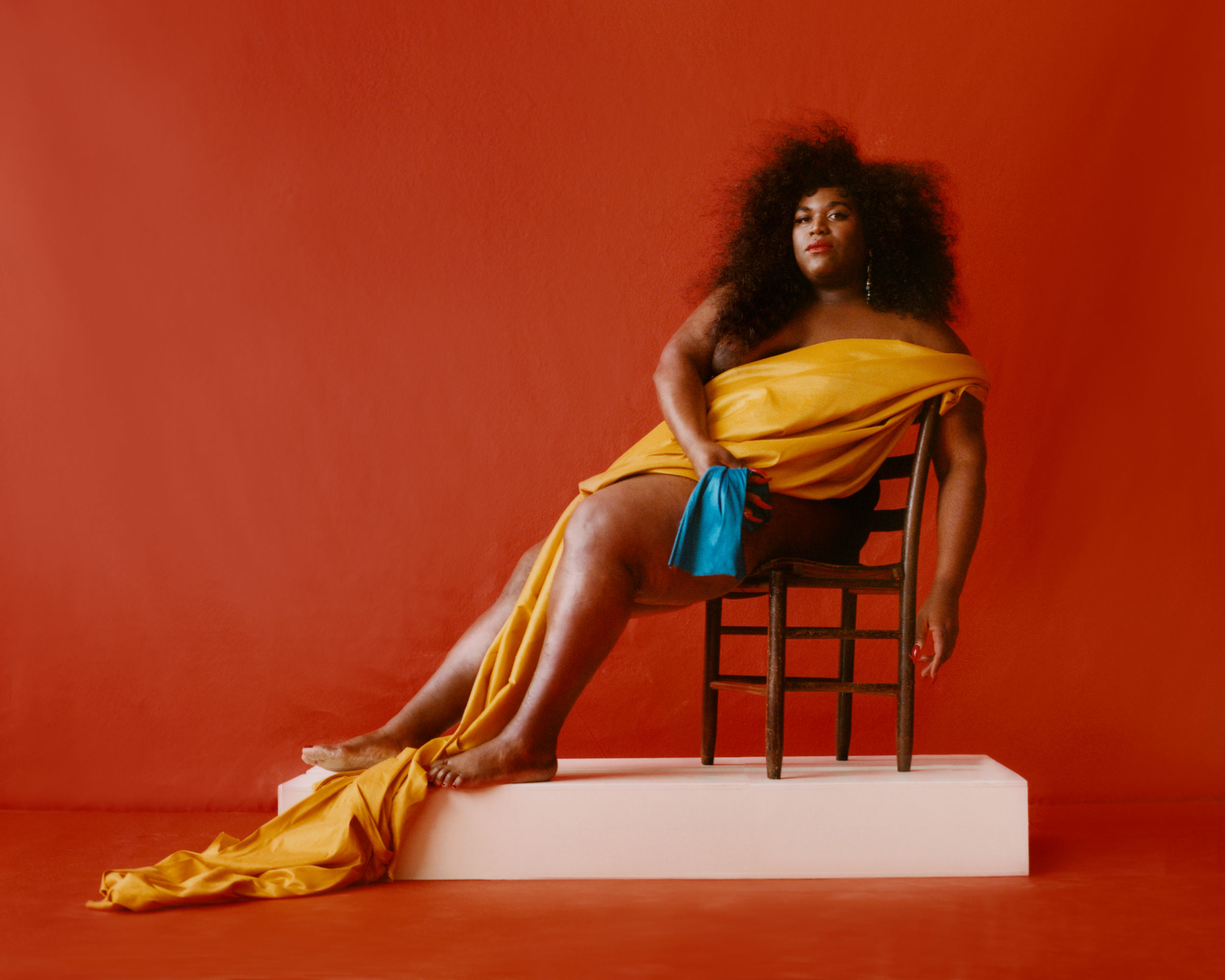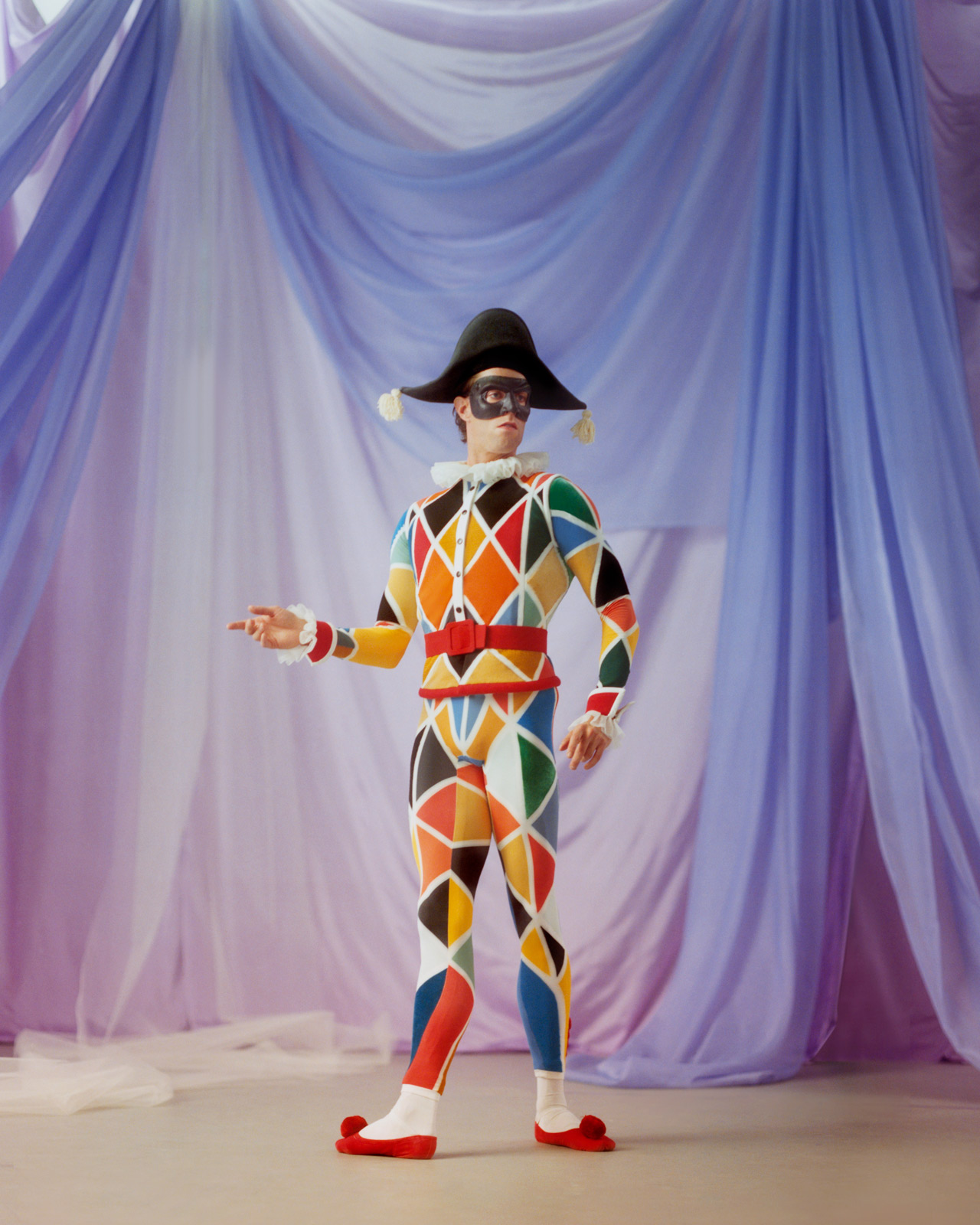With her first solo exhibition, ‘Gods That Walk Among Us,’ the photographer imagines activists, muses, and performers as gods
“Camila Falquez is undoubtedly a radical visionary,” says Qween Jean, friend, collaborator and subject of Falquez’s first solo exhibit, Gods That Walk Among Us.
Twenty-eight vibrant photographs shot in Cuba, New York, Puerto Rico, and Spain over the last five years feature Falquez’s interpretation of royalty. From personal to commissioned, the works in the exhibition depict a variety of activists, friends, muses, and performers with whom Falquez has developed long-standing relationships.
The photographer creates with vibrancy and voice. She empowers her subjects, depicting them as gods and goddesses by putting them on literal pedestals, draping them in saturated fabrics, and posing them in their power, like Greek statues. The work feels monumental, but lacks the seriousness that is normally tied to traditional portraiture.
Falquz emphasizes the collaborative effort in all of her creations. Her brilliant eye, her unquestionable talent, her hard work, and her dedication are all prominent within this show. Nothing shines through more than her unconditional love and desire to exemplify that love. Not only does her work allow for her subjects to feel seen, beautiful, powerful, and vital, but it allows an audience to see themselves in all of that, too.
There is no denying the warmth and tenderness Falquez exudes. She moves through the world with love dripping from her—from her message, from her imagery. It’s in the way the Qween describes her: “Her rhythm flows from the moment you meet; it aligns with your heartbeat and stirs up indescribable yet familiar sounds. You begin to feel light and glide in stride with her choreography. Camila has the power to pull out the vulnerability and present it with genuine care and integrity.” Qween continues, “When you’re in front of her camera, you find yourself lighting up and shedding the pain and sorrow you’ve been carrying.”
As we discussed Gods That Walk Among Us, Falquez spoke of the influence her dear friend Qween had on her, and more specifically, on The Family Portrait—one of the standout works exhibited in the show, depicting the idea of “a chosen family.” “The Family Portrait is simply home. It is the family portrait I had dreamt of as a child,” Qween shared. She is at the root of the image’s inception, collaborating with Falquez to show those in Qween’s life who represent family to her. “There was no fear or worry that day. It is composed of many pieces joining forces to achieve perfection. Each saint is adorned in their finest armor, draped in the finest silks and accented in golds and polished mosaics. Their flesh and layers of survival are all woven together and beam radiantly in the light. In this family, we command respect and never bow our heads to fragility, transphobia, and all forms of systemic oppression. Instead, we rejoice and rise above!”
Ryan Williams: How did you start developing this project?
Camila Falquez: I haven’t produced much new work for the show. I produced the family photo, and a portrait of Qween. The rest is work I’ve done in the past five years. I’m a working photographer. I don’t come from money. I never thought of myself as an artist. I’ve never had the luxury of stopping and thinking, “What is it that I’m saying?” [Hannah Traore], the owner of the gallery, reached out [about doing an exhibition]. I, also, have this group of incredible women helping me from my agent to my advisor. I was like, “Okay, I have to go to India and shoot.” They were like, “Stop, stop—because this show already exists. You have it.” I realized that, unconsciously, for the last five years, I’ve been creating this show without really having the intention of that.
Ryan: You’ve said that, with previous work, you noticed yourself turning to references from the European Renaissance and wanting to move past white standards of beauty. What was that like for you, going into this project?
Camila: All the work I’ve done is either on the internet or in magazines. So to now stop and go back to that work, and bring it onto a physical plane is very important, because it deserves it. I feel that the people in the photographs, and what we’re saying with them, need to arrive to all of these new spaces, to all of these institutions, to all of these walls. I’m not selling editions. I’m selling unique pieces. Every photo is framed with silk that I brought from Spain. It’s like a painting and it’s treated the same. The intention behind that is precisely that it persists and it’s not reproductive.
Ryan: What is your process?
Camila: I do very labor-intensive work with every photo of mine. I do my own backdrops. I paint them all. I source the paint. I bike and get fabrics. There’s this pilgrimage leading up to each photo that I’ve realized is like my creative process. I don’t know how to just show up to set without having done it. It’s where I put love and where I put intention. [My subjects] arrive to my studio, and the music is playing. And my Colombian friend makes the food. It takes this spoiling of the characters to make them feel safe, make them feel seen, make them feel like catered to and nurtured.
Ryan: I heard about the Salsa, Rumba and Flamenco music you play on set. Why is it important to you to create an atmosphere like that when you’re photographing someone?
Camila: You can’t hear it, and they’re not even dancing in the photos, but every single photo has music behind it. I just can’t create without that. I think it reads in a certain layer of the photo. We dance on set.
Ryan: It definitely shows through in your work. There is love in the labor of it. Color is such a prominent thing in your work. You spoke about creating your own backdrops. How do you go about deciding the color palette?
Camila: I haven’t really arrived as to why I use certain colors or not. I’m Mexican, Colombian, Spanish, so that requires color in a sense. And as a kid, I was a very colorful person. But I went into my teenage years, and it was a beige time in photography. I blended in. There is this one photo of a dancer, James, who I was shooting for a campaign. I didn’t direct it, but James arrived on set in a harlequin costume. It was a purple set. I shot that photo, and I promise, if you go back to my Instagram, from then on it’s color. Since then, I’ve just been exploring color and realizing that there’s this very elegant way of using color that people are really afraid of.
Ryan: How did you go about choosing which subjects to showcase in this exhibition?
Camila: I just fall in love. I don’t know if I’m such a talented photographer. My talent is falling in love. I just don’t question it. This show is a mix of older women, indigenous women, trans women—what connects them to me is that they are royalty. Royalty and gods that are working, working for real, for their communities. They’re revolutionaries.
Ryan: I feel like the conversation about representation and visibility tends to lean towards the question, Is there a profit? I feel that’s something that never crosses your mind at all. Does the reception of the work decide the success of it for you, or is the success in the creation?
Camila: I’m putting a lot of love into all of this, hoping deeply that this really protects us, hoping that we feel strong. I don’t want any of these people to feel that I’m just exposing them without intention. I ask a lot of these subjects, and all of these incredible humans. They are in front of a camera, very visible in new space. The world is crazy right now. I’m just hoping that we are solid, protected with a lot of love and care.
Ryan: It’s such a special project in so many different ways. What makes you feel powerful?
Camila: Every time someone trusts me to photograph them. I have this responsibility here. Every time, I can’t believe it.
Ryan: Photographing people can be quite intimate. There has to be trust, or else it’s not going to be authentic.
Camila: Especially in how I do it. It’s a profound act of trust.I just hope these pieces make it into new spaces, new institutions—not for me, but because they deserve it.
Gods That Walk Among Us is on view at Hannah Traore Gallery through July 9.
































